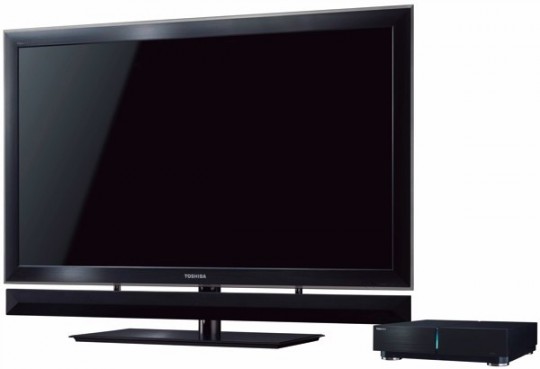
Sweet, it’s just what the world needed: An HDTV that uses the powerful Cell chip, currently used to power the PlayStation 3. OK, so may not seem like a match made in heaven (and you still can’t play Uncharted 2 without owning a separate console – bummer), there nonetheless remains plenty of promise in Toshiba’s new Cell TV series of premium sets.
All but guaranteed to ship with a price to match, these models, available in two lines – the Genensis Design (55″ and 65″ units) and Illusion Design (46″, 55″ and 65″ models offered) families – threaten to make both primetime and movie time more enjoyable. Thank 1080p upscaling of movie and television content; the ability to display images in 3D (including 2D content that’s converted over); and a built-in 1TB hard drive and wireless 802.11n networking for retrieval of networked or online content. The sets even promise to polish up those videos you shot for your blog, adding pixels and contrast to get them to semi-watchable quality, finally giving viewers the ability to tell skaters apart from the trees they’re so often recorded crashing into. Mind you, 480hz refresh rates don’t hurt either, promising smooth motion in nearly any mode, making it all the more enjoyable to watch balls fly in your favorite sporting event (provided it’s not professional quilting).
But while the specs are certainly impressive, what really piques our interest is the convenience these HDTVs will ostensibly place at your fingertips. While connected home theater components have offered many of these same features (content upscaling, streaming media, USB media support, Internet video playback, etc.), few have provided such an all-in-one solution. From a built-in Blu-ray player to automatic set calibration that actually senses the room’s color temperature and adjusts your TV accordingly, there seems to be a vast and compelling suite of features here to satisfy all comers.
What we really want to know though is how well it’ll all work in practice, whether we’re looking at feature overkill and just how much it’ll cost to enjoy this kind of luxury and convenience? Because realistically, you’re staring at way more power than the average TV viewer is apt to use in the course of a single set’s lifetime, let alone on a day to day basis. Will it be worth the asking price? Are these features implemented in such a way as to be practically accessible by less tech-savvy consumers? Do you even need to consider shelling out for a set that crams so much crap into a single screen? These questions remain to be answered, preferably while kicking back, opening a cold one and watching a 3D home conversion of Avatar, and not just at your friend who owns the palatial estate’s place.



